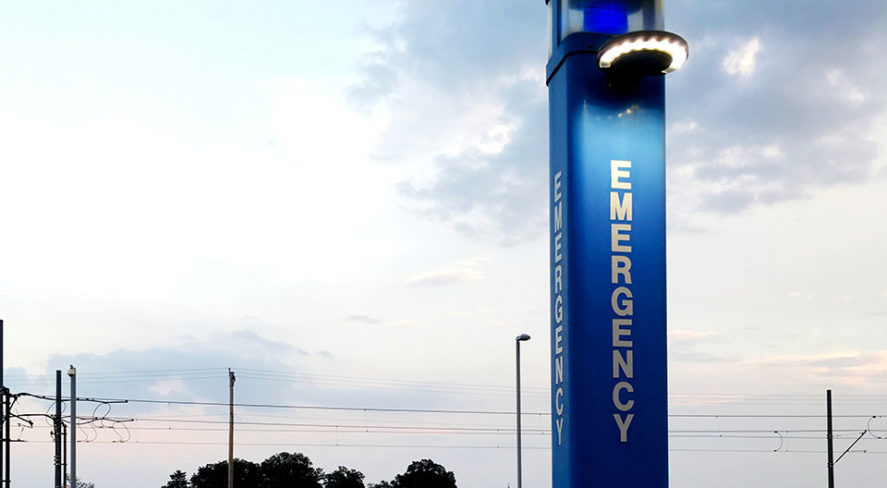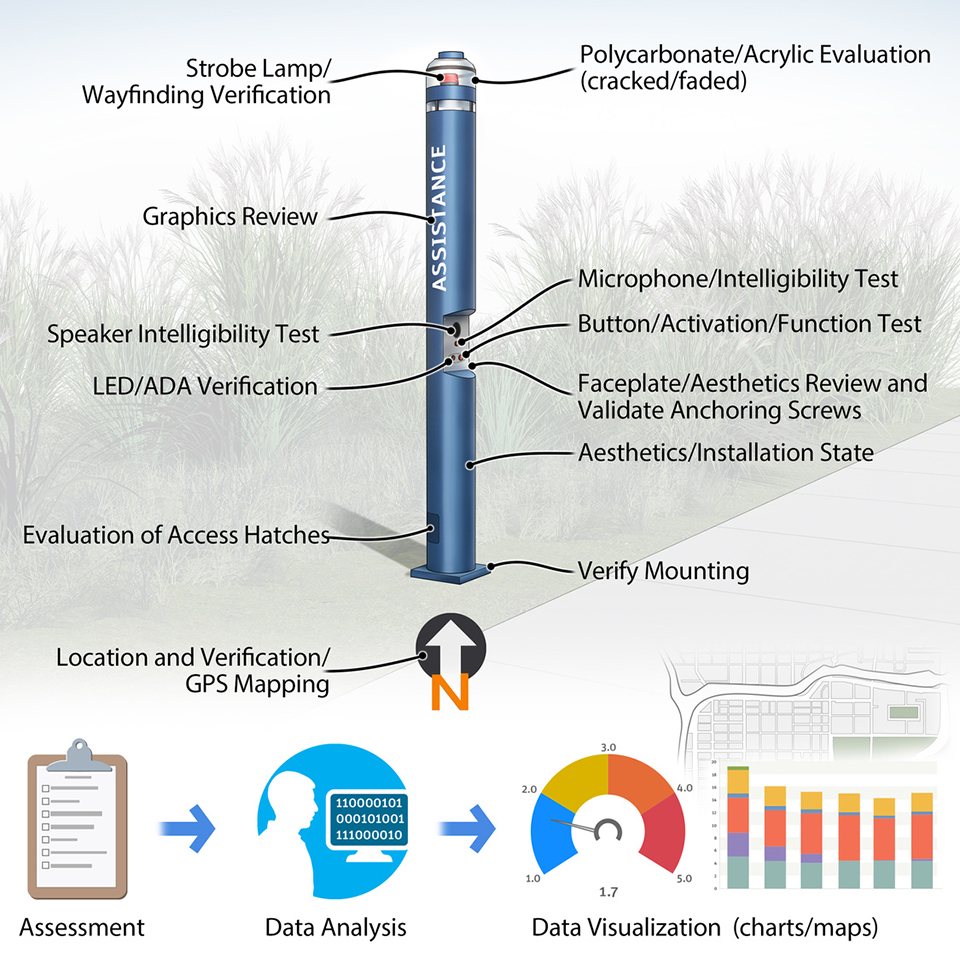Call Boxes in a Mobile Age

Transitioning to apps is not as clear cut as it may seem
I am attending a university orientation tour, and our guide is talking about the importance of safety/security and policing at the university. This piques my interest. The guide points to a call box and says, “These call boxes are located throughout the campus and directly call the police,” boasting about the campus law enforcement response time.

The call box is adorned with Greek stickers and chewing gum, and at the top a dim blue light is visible through the spider cracks and a yellowish haze of a once cloudless dome. The guide activates the call box, which bursts to life with a dial tone, followed by a pre-programmed number, which is answered immediately: “This is University Police. State your emergency.” As the group is in awe of the audio spectacle, I notice the dim blue light is unwaveringly steady.
We continue our walk through an open courtyard. A woman from our group exclaims, “I don’t see any blue light phones here.” The guide replies, “Yes, the university is moving away from call boxes in favor of iOS and Android mobile applications.” The guide is very excited about this, continuing, “The app is free to download and is a much faster and more convenient way to contact help.” Additionally, “It supports virtual escorts, anonymous reporting, and in an emergency, it can broadcast messages that all staff, visitors, students and even parents can subscribe to.” As I look down at my phone, I see something interesting.
I have no signal.
History
The call box solved the problem of facilitating communication in areas where people are alone and need help (e.g., on the highway). Previously, this audio-only device used plain old telephone service (POTS) to connect people through several interconnected phones wired in a series on a single speech path, commonly referred to as a party line. While cost effective, malfunctioning and off-the-hook phones inevitably created noise on a line.
The Clery Act of 1990 imposed crime reporting requirements on universities following the sexual assault and murder of Jeanne Clery, a 19-year-old student at Lehigh University. The Clery Act led Illinois University to ask inventors and product manufacturers to address the risk of students traversing the campus alone and without communication. Responding to the challenge, a company called News Time proposed a box with a red button and a blue light atop its enclosure. Upon pushing the red button, the device autonomously dials a pre-programmed number and subsequently opens two-way communication with a constantly attended police or security site. The devices go by several names: call for assistance, emergency phones, blue light phones, blue phones, and call boxes. Predominately, call boxes are found on campuses, but they are also in remote areas where conditions might leave people without means of communication. This includes parking garages, walkways/pedestrian corridors, and buildings or areas where medical aid might be needed (for example, fitness, pool and athletic areas).
With time, however, these devices begin to resemble something from a post-apocalyptic movie. Covered in spider webs and faded by the sun, they become havens for animals and insects.
The age of these systems is not the only challenge. Technology has evolved and, as phone providers, which offered the highest reliability available, are shuttering, organizations are moving to voice over Internet protocol (VOIP). The public branch exchanges (PBX) that route phone calls are no longer supported, and call boxes are forced to add a foreign exchange office (FXO) to convert POTS to VOIP in order to maintain connectivity. Outside FXO, the move to VOIP has created significant challenges for those who maintain call boxes. First, the phone instrument has to change; second, the line must be isolated from ground loop and surge; and, finally, it needs to maintain the same reliability as its analog/POTS predecessor. That means electrical and data redundancy at the logical and physical level for any path that emergency communication might take.
Case Study
A security technology analysis of a large university included an examination of the emergency call box system, which was a mix between cellular/solar, POTS and VOIP (copper fiber transmission). The systems had not transmitted an emergency call in some time, and they were predominately being used for complaints (tickets, damage to cars, etc.), information needs (directions to a building), and verification of the system’s operational status. There was no clear ownership of the hundreds of call boxes that had been deployed. The university’s technical services personnel maintained them, the campus police tested them, a third party repaired them, and the facilities department had installed them.
At approximately $20,000 per device, the university was consciously installing solar/cellular units because of the initial cost savings. It failed to account, however, for the campus location frequently having high overcast skies. While this was already problematic, a review of service tickets revealed that the majority were due to battery failures. Disassembly is the only way to remove the battery, so replacement was a time-consuming process. Instead of deep-cycle lead acid batteries, the university had chosen nickel-cadmium and nickel–metal hydride batteries, which are prone to a memory effect. This is when a battery “remembers” a progressively smaller portion of its total capacity and holds less and less of a charge following repeated complete discharges. The lack of solar radiation and proper battery type led to a high failure rate for the cellular/solar installed units. University technicians, meanwhile, severed the power to the wayfinding light and strobe features, hoping to prolong battery performance.
Testing the system revealed another problem. When the pre-programmed number was dialed, dispatch, as expected, answered, “University Police. What is your emergency?” However, when the dispatcher was told the call was a test and was asked, “Where are we,” the response was, “I don’t know. It says wireless caller.”
Other Observations
The following is a list of other considerations and observations that could be impactful to call box design, maintenance and operation.
- Aesthetics are important. The first impression of a call box to a prospective student, employee or patron is key. If the call box does not look like it works, then it will not be used. There is no better way to tarnish an organization’s security image than to have a dilapidated call box, even if it is functional. Make sure the aesthetics match the organization’s brand and colors, prevent corrosion and keep the paint and graphics fresh.
- Pick a name. Is the device for emergencies? Is it call for assistance? Mixing the names of these devices can create enormous challenges.
- When converting to VOIP, don’t forget the call boxes. In one instance, a parking garage transitioned to pay-on-foot stations. Attendants were furloughed, but the organization forgot to reprogram the boxes to call a new number offsite, so all of the call boxes dialed a number that had been disconnected.
- As the adage goes, location, location, location. Call boxes should be installed with consistency in mind and should be accessible without creating entrapment. Do not place call boxes in drive lanes or in areas where someone with malicious intent can block escape routes. Handicapped access must be considered, and not just for the call box; indirect approaches should be confirmed. Of utmost importance, maintain visibility and place call boxes along expected paths of escape.
- Call boxes should always have a wayfinding light and a strobe luminary. This is critical to deterring malicious actors. A high-powered strobe will call attention to the area and help first responders find it and the person who called. Ability to access a location is also critical. One installation had a call box in a garage stairwell that had been fenced in, making it difficult for anybody to provide assistance.
- The communication infrastructure should always be single mode or multi-mode fiber. Copper cabling can be problematic, especially when water gets into the conduit. When considering technology, be cognizant of the logical and physical networks that are required for high reliability. This means redundant switches, which should be used as the communication path for call boxes. It also means backup power and communication systems for all devices that support communication (fiber transceiver, switches, etc.).
- A call box that is installed incorrectly will only create issues. Ensure that connections to the call box are made from the bottom, not the top. Ensure that vertical conduit is not stacked where call boxes are interconnected. When call boxes are interconnected box-to-box, condensation, corrosion and low voltage electrical shorts will inevitably occur.
- Coordination between call boxes and automated parking systems is important. Automated parking systems use blue lights to convey open handicapped parking spots, whereas call boxes typically use blue lights to communicate locations. In a sea of blue lights, it can be difficult to determine the difference.
- Tagging is often overlooked, but it is essential. Tagging – numbering call boxes with welded anodized tags (not vinyl tags) – communicates the exact location of the call box and supports maintenance. It helps correct issues like the large, angry hornets’ nest that the author unwittingly and regrettably disturbed during testing at one site.
- Clear ownership is needed for these systems. It is not uncommon to find call boxes that are in operation but are marked as not operational, as well as unmarked call boxes that do not work. When a call box is not functional, it should be completely turned off, including the wayfinding light.
- Technology can support the testing of systems, but the technology should be universal. Sometimes, autonomous testing can only be done on VOIP call boxes, not on analog call boxes. Make sure the systems are all tested in some fashion.
The New “Widget”
The problems cited above often result from years of neglect. It can seem easier to simply buy a “widget” to solve a problem instead of fixing the technology. Unfortunately, people sometimes react right away and do not take the time to understand the full depth of the technology and its interdependencies. The challenge with call boxes is that rapidly-changing technology can render these systems obsolete and/or useless. Organizations who recognize that change needs to happen are looking toward iOS and Android mobile applications to replace call boxes while decreasing the cost of repair for unused technologies and systems. VOIP has overtaken analog POTS systems and most individuals have a cellular phone.
Unfortunately, the solution is not that simple and here’s why.
- When it comes to campus safety, mobile applications need to be trusted. According to Campus Safety magazine, “Estimates suggest that only 7% download the emergency notification apps and only 10% of those users will enable location services. That means you can only reach 7% of your audience in an emergency and that the super geo-location features the app vendor claimed would revolutionize your safety system are only effective with less than 1% of your base.”
- The mobile app needs to come with training and conditioning people. That conditioning must include awareness. Somebody who is surprised by an attacker will need to remember how to access their phone and app, or proactively have the phone “awake” with the app operating. Mobile devices are very distracting. People focused on texting who walk into walls and poles is common, and noise canceling earbuds and headphones lead to people being even less aware of their surroundings, making them excellent targets of opportunity. Furthermore, the app does nothing for people who forget their phone or who have drained the battery to zero by posting on social media and texting with friends.
- Third-party infrastructure needs to be verified. Is there cellular/wireless repeatability within parking garages and other buildings? The move to digital and Federal Communications Commission frequency re-farming indirectly reduced signal propagation. Signal propagation is not confined to one provider, so all 30 wireless communication companies must be considered. Many times, there is little to no signal propagation in buildings, parking garages and large open spaces.
- A cellular survey needs to be conducted to ensure that cellular propagation is present. What does it take to provide cellular propagation? A distributed antenna system (DAS) is a series of antennas that repeat signals from outside the premises within a building. DAS infrastructure is significant because it must replace the reliable communication offered by POTS. Thus, electrical and telecommunications redundancy, a bunch of batteries, and related maintenance are needed. Those costs for a new building can be $1 to $1.50 per square foot (conservatively) for a new passive DAS. For an existing building, the costs can double or triple because of the restoration work needed after the DAS installation. DAS is becoming a code requirement within buildings, and organizations must consider that, if they are going to embrace apps, the infrastructure to get the communication out needs to be in place. And this infrastructure needs to be everywhere, as opposed to the select locations for call boxes.
- If and when cellular carriers move to 5G, DAS will become even more important, because 5G does not propagate well through building materials. Future frequencies will require DAS infrastructure and transmitter/repeater system upgrades.
Planning
The decision to keep or remove call boxes is a multi-stage process. First, the existing state for all call boxes, along with the technology that is being used for the transport of this emergency communication, must be determined. It is not just the call box, it is the interconnectivity, redundancy and reliability of these systems that need to be evaluated. A comprehensive analysis should include geolocation, a complete testing of all call box facets (see Figure 1), aesthetics, location verification, entrapment evaluation, and general and Americans with Disabilities Act accessibility, along with a comprehensive evaluation of dispatch logs, maintenance, and service tickets. An analysis should also include the current device installation standards and the organization behind the management and maintenance of call boxes.

An organization should also consider a security risk assessment to identify environmental and criminal factors in relation to call box placement. With this information, a separate and simultaneous cellular/radio repeatability test should be done. This should also include an evaluation of recurring costs for awareness programs and training that are required with app-based communication. All of this information must have documentation. It informs the business decision of whether to remove, keep, update or augment call boxes.
The New Need
Many call boxes use fiber and network (TCP/IP). A host of possibilities are opened with fiber. It is a good idea to purchase call boxes that support both informational and emergency needs. Informational needs could be directions to a location on campus, getting help for a flat tire, or calling for transportation service. These boxes should be outfitted with big voice systems to supplement mass notification; microphones for monitoring/analyzing gunshots, screams and calls for help; wireless antennas (Wi-Fi) and cellular radio repeatability; multi-image, megapixel cameras that can be utilized with analytics (to detect fighting and weapons); LED lighting; and related features. Fiber optic cable opens several “attachments” that can be used with these devices for functions that have not yet been considered.
Making the Decision
While there are several environmental factors at play, and the knee jerk reaction is to replace call boxes because everyone is connected via mobile technologies, it may not be the right decision. Organizations need to consider if mobile technologies would be a deterrent, if people know how to use these technologies in an emergency, and if the communication will make it to someone who can provide help. They need to define what entity owns, maintains, repairs and services this equipment, and they must remember that these entities may have become biased to the device operations, so random, recurring third-party testing should be considered. Organizations should also drill on these devices, such as with a random mock emergency activation.
For many organizations, the move to VOIP has left unanswered questions regarding reliability and redundancy, both of which were present with POTS. The wrong approach could lead to loss of life and liability exposure.
About the author: Sean Ahrens (sahrens@aeieng.com) is the security market group leader at Affiliated Engineers (www.aeieng.com).
